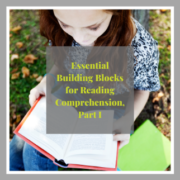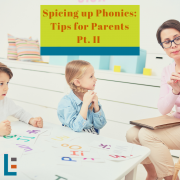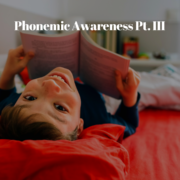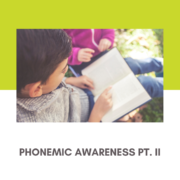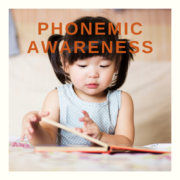Essential Building Blocks for Reading Comprehension, Part I
Many of us don’t actually remember learning how to read. We may remember sitting on our kindergarten carpet squares, picking out new picture books at the school book fair, or feeling the excitement of turning the final page of a book read independently for the first time. Those fond memories are certainly associated with the skills one must acquire in order to first learn to read; however, we cannot necessarily remember the actual process of learning how to comprehend the words on the page. Thinking about it now, reading almost seems like an innate skill, as though reading just happens. If only that were the case…
Sadly, reading comprehension can be a labor intensive task for many young learners. Some children can fool us on the surface; they may learn to read fluently, briskly, and accurately, as though they are natural-born readers. However, reading fluency and comprehension do not always go hand in hand. Children may acquire the necessary skills to read clearly and accurately, but, try as they might, these same kids may simultaneously struggle with the ability to digest or comprehend a text. So, if it is not a natural or innate skill, what goes into reading comprehension anyway?
Part of the reason why reading comprehension can be a struggle for many learners is the fact that the process involves a compilation of other complex skills. Such foundational skills necessary for children to begin to master reading comprehension include: fluency, phonemic awareness, accessing prior knowledge/making connections, vocabulary, syntactical rules/conventions, working memory, and attentiveness.
Fluency Strategies
- Review sight words and high frequency words regularly
- Turn fluency practice into a game by setting timed records, racing against the clock, and matching spoken sight words with word cards
- Practice pronunciation by modeling and rehearsing
- Clap period stops and snap comma pauses to improve punctuation recognition
- Repeat readings to help with word recognition
- Always read aloud to and with your child
- Model and practice reading with expression
- Give your different characters a “voice” while reading aloud to your child
- Preview or expose children to the new or unfamiliar words before giving them the reading passage
- Utilize poetry, nursery rhymes, and songs to practice fluency
Phonics Strategies
- Use photos/images to match objects with corresponding beginning sounds
- Practice sorting words into “like” sound piles using word cards
- Create a word wall in your child’s bedroom or playroom
- Play “blend bingo” using bingo cards and corresponding images of words that include each consonant blend
- Use Scrabble tiles to “build” sounds
- Use rhyming strategies to group/categorize words
- Play “which one of these is not like the others?” using word cards
- Use tapping, clapping, or any other kinesthetic method for sounding out words
Background Knowledge Strategies
- Expose your child to a variety of text types and different genres to create a repertoire of background information
- Incorporate alternate media, such as movies, art, news, television, etc.
- Teach new words in categories to help solidify new terms with prior knowledge
- Practice word mapping to build connections
- Compare and contrast words and concepts while reading
- Preview new texts or frontload unfamiliar information using references or just casually discussing the topic
- Use KWL charts to track knowledge of new concepts/topics
- Utilize picture books, regardless of age, to pair images with new words
- Take virtual field trips
